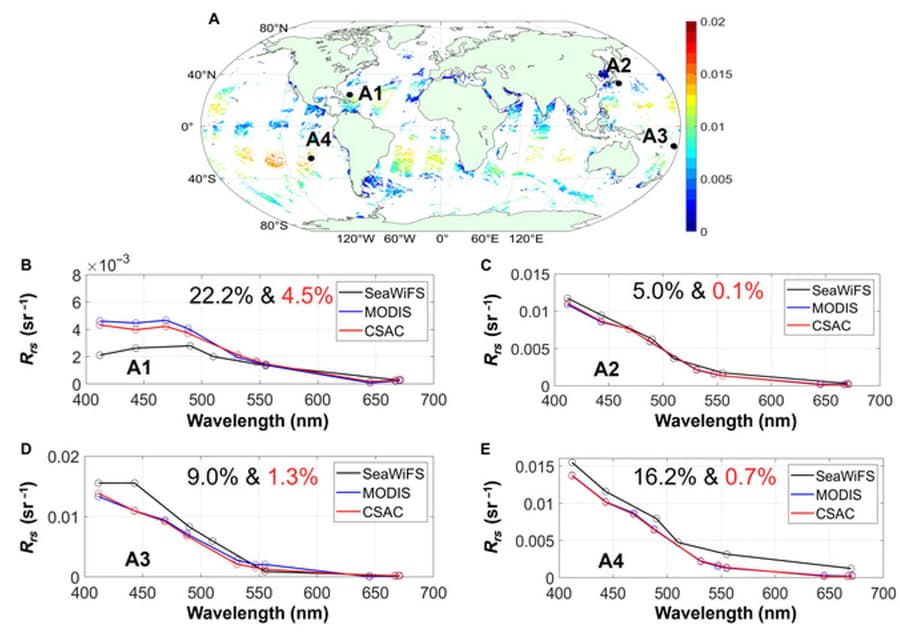New Satellite Data Fusion Method Revolutionizes Ocean Monitoring
December 21st, 2024 8:00 AM
By: Newsworthy Staff
Scientists have developed a groundbreaking system called CSAC to harmonize satellite ocean color data, enabling more accurate long-term monitoring of marine ecosystems and climate change impacts on oceans.

In a significant advancement for oceanographic research and climate science, researchers have unveiled a new method to harmonize satellite ocean color data across multiple platforms. The Cross-Satellite Atmospheric Correction (CSAC) system, developed by scientists at the State Key Laboratory of Marine Environmental Science at Xiamen University in collaboration with the National Satellite Ocean Application Service, promises to revolutionize how we monitor and understand our oceans.
The CSAC system addresses a long-standing challenge in satellite ocean color remote sensing: the inconsistencies in data across different satellite missions. These discrepancies, arising from variations in sensor design and atmospheric correction algorithms, have hindered efforts to create comprehensive, long-term datasets crucial for monitoring climate impacts on the oceans. By aligning top-of-atmosphere reflectance data from various satellites with the highest-quality remote sensing reflectance (Rrs) data compiled by MODIS-Aqua, CSAC effectively resolves these inconsistencies.
The implications of this breakthrough are far-reaching. With CSAC, scientists can now produce reliable, long-term data products from multiple satellite missions, spanning decades. This capability is vital for observing shifts in ocean ecosystems, examining the ocean's role in the carbon cycle, and evaluating the impacts of climate change on marine environments. The system's ability to reduce discrepancies in Rrs across wavelengths by up to 50% compared to traditional methods underscores its potential to significantly enhance the accuracy and consistency of ocean color records.
Dr. Zhongping Lee, one of the study's lead researchers, emphasized the significance of CSAC, stating, "By harnessing decades of the highest-quality MODIS-Aqua data and sophisticated machine-learning techniques, we have resolved critical inconsistencies in Rrs among different satellites. This not only improves data reliability but also empowers the scientific community to create accurate, long-term records of ocean bio-optical properties, essential for climate studies."
The development of CSAC marks a paradigm shift in satellite data processing. Unlike conventional atmospheric correction approaches that require sensor-specific algorithms, CSAC employs artificial intelligence to process data from multiple satellites uniformly. This AI-based approach sets a new standard for future satellite data processing, signaling a transition from radiative-transfer-based approaches to more sophisticated data-based systems.
For the scientific community and policymakers alike, the advent of CSAC represents a significant step forward in our ability to understand and respond to global climate change. The improved consistency and accuracy in ocean color data will enable more precise tracking of changes in marine ecosystems over time. This, in turn, will provide valuable insights into the health of our oceans, the effectiveness of conservation efforts, and the broader impacts of climate change on global water systems.
As we face increasing environmental challenges, tools like CSAC become indispensable for informed decision-making and policy formulation. The ability to generate comprehensive, long-term datasets on ocean bio-optical properties will support more accurate climate models, enhance our understanding of oceanic carbon sequestration, and help predict future changes in marine ecosystems.
The development of CSAC underscores the critical role of technological innovation in environmental science. As we continue to grapple with the complexities of climate change, advancements like these provide hope that we can better understand and potentially mitigate its impacts on our planet's most vital ecosystems.
Source Statement
This news article relied primarily on a press release disributed by 24-7 Press Release. You can read the source press release here,
